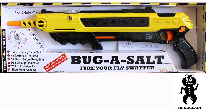My workspace at work occupies the lobby of our business, and I am virtually alone all day, except for the vendors and co-workers who traverse my area periodically. Thus, I often whistle or hum to myself while I work, knowing that my "music" won't bother anyone. Last week I was whistling tunes from old TV sitcoms and Sara came to speak with me just as I was finishing whistling a stanza of the "The Brady Bunch" theme song. She just glared at me and said, "Thanks for the earwig."
Sara was talking about a tune that gets stuck in your head that you can't seem to shake, and not the insect by the same name. An earwig is menacing-looking insect, with large forcep-like pincers on its end. And, contrary to myth, earwigs do not burrow into your ear canal to lay eggs that will eventually hatch with resulting earwigs feeding from your brain. Perhaps the myth perpetuated from the fact that earwigs are slender, like to hide in moist places, and could actually fit into a moist ear canal. Yet, that is simply a myth.
Here are some actual facts about earwigs:
The female earwig creates a burrow about three inches below the soil in which to lay her eggs, and can lay up to 60 eggs at a time. Earwigs over-winter in the soil and then hatch, living only one generation.

Have Fun Getting Those Pesky Flies! Get rid of them with the original salt gun. Use a pinch of salt, pump the handle, turn the safety switch, aim, and fire. Kills flies within 3 feet with virtually no mess. Won't harm glass, windows, or walls. Check out Bug-A-Salt today!
While moths can be annoying and disruptive to your summer outdoor party, certain species can be destructive and deadly to ...
Discover MoreIf you're having problems with snails and slug eating away your vegetable garden, destroying your flower beds, or ...
Discover MoreWhile it might be nice to learn methods you can use to remove bugs from your home, wouldn't it be better to learn how to ...
Discover MoreThere are currently no comments for this tip. (Be the first to leave your comment—just use the simple form above!)
Copyright © 2026 Sharon Parq Associates, Inc.
Comments